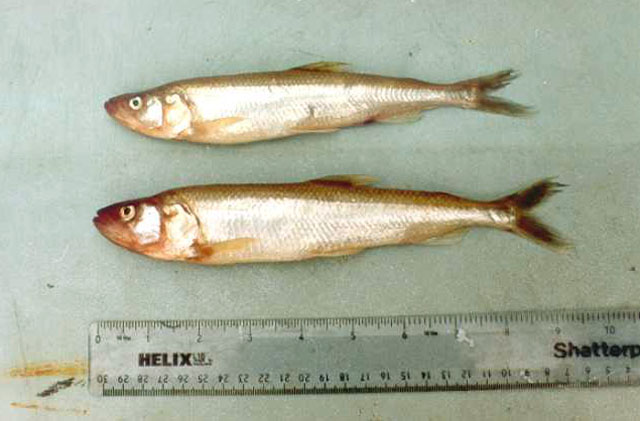| Osmeridae (Smelts) |
| 45 cm TL (male/unsexed); max.weight: 178.0 g; max. reported age: 10 years |
|
pelagic-neritic; freshwater; brackish; marine, anadromous |
| North Atlantic: White Sea southward to western coasts of France including Baltic Sea, southern North Sea and British Isles (Ref. 4545); the Gironde estuary is the southern limit of his distribution (Ref. 51442). Landlocked populations in lakes of coastal areas of North, Baltic, White and Barents Sea. North to about 68° N in Scandinavia (Ref. 59043). The former nominal subspecies Osmerus eperlanus eperlanus is recorded from the coasts and drainage of White and Barents Seas westward through Baltic Sea to Denmark and it is primarily lacustrine (Ref. 4545). The former subspecies Osmerus eperlanus schonfoldi (Rutty 1772) is sympatric with the nominate subspecies in parts of Poland, Denmark and the Baltic, and it is primarily anadromous (Ref. 4545). |
|
Dorsal spines (total): 0-0; Dorsal soft rays (total): 9-12; Anal spines: 0-0; Anal soft rays: 12-16; Vertebrae: 55-62. Body long and slim (Ref. 4545). Head rather pointed (Ref. 4545). Snout pointed (Ref. 4545). Upper jaw reaching to hind margin of eye, lower jaw projecting a little (Ref. 4545, Ref. 51442). Teeth in lower jaw larger than those of upper, strong teeth on tongue and canines on vomer (Ref. 4545). Dorsal fin origin behind base of pelvic fins (Ref. 4545). Incomplete lateral line is developed near the head (Ref. 51442). Dorsal side light olive green, flanks silver stripe, belly creamy white (Ref. 4545). |
| Inhabits marine waters, estuaries and large lakes (Ref. 59043). A midwater species, rarely far from shore, primarily anadromous in the west and lacustrine in the east; shoaling at least during spawning season (Ref. 4545). The essential part of its life is spend in the estuarine zone, with just short incursions in the littoral zone (Ref. 51442). The migratory form is grouping together in the estuarine zone for reproduction (Ref. 51442). Enters the rivers for spawning on sandy or gravely bottoms (Ref. 13696). Spawns in tributaries of lakes or along shallow shores of lakes and rivers on sand, gravel, stones and plant material, preferably in fast-flowing water (Ref. 59043). Reproduction takes place between February and May, depending on the water-temperature (Ref. 51442). Produces 8,000-50,000 yellow eggs with a diameter of 0.6-0.9 mm which adhere to the bottom (Ref. 13696, Ref. 51442). Eggs hatch in 3-5 weeks and the larvae descend to the estuarine zone (Ref. 13696, Ref. 51442). Feeds on shrimps and small crustaceans; larger individuals feed on small fish (Ref. 30578, Ref. 51442). Utilized as foodfish, smoked, as bait and fish oil (Ref. 35388). Smells like cucumber (Ref. 37032, 51442). Locally threatened due to pollution and barriers to migration (Ref. 59043). |
|
Least Concern (LC); Date assessed: 05 March 2010 Ref. (130435)
|
| harmless |
Source and more info: www.fishbase.org. For personal, classroom, and other internal use only. Not for publication.

